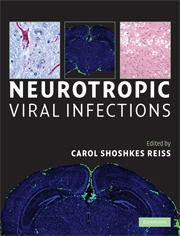Book contents
- Frontmatter
- Contents
- List of contributors
- Foreword
- Preface and acknowledgments
- Section I Introduction: RNA viruses
- Section II Introduction: retroviruses, DNA viruses, and prions
- Section III Introduction: immunity, diagnosis, vector, and beneficial uses of neurotropic viruses
- 14 Innate immunity in viral encephalitis
- 15 Role of Toll-like receptors in neurotropic viral infections
- 16 Neuroendocrine-immune interactions in neurotropic viral infections
- 17 Epidemiology of viral encephalitis
- 18 Pathogen surveillance and discovery
- 19 Clinical management of viral encephalitis
- 20 Influences of arthropod vectors on encephalitic arboviruses
- 21 The role of bats as reservoir hosts of emerging neurological viruses
- 22 Viral oncolysis of glioblastoma
- 23 Viral gene therapy for central nervous system diseases
- Index
- Plate section
- References
16 - Neuroendocrine-immune interactions in neurotropic viral infections
from Section III - Introduction: immunity, diagnosis, vector, and beneficial uses of neurotropic viruses
Published online by Cambridge University Press: 22 August 2009
- Frontmatter
- Contents
- List of contributors
- Foreword
- Preface and acknowledgments
- Section I Introduction: RNA viruses
- Section II Introduction: retroviruses, DNA viruses, and prions
- Section III Introduction: immunity, diagnosis, vector, and beneficial uses of neurotropic viruses
- 14 Innate immunity in viral encephalitis
- 15 Role of Toll-like receptors in neurotropic viral infections
- 16 Neuroendocrine-immune interactions in neurotropic viral infections
- 17 Epidemiology of viral encephalitis
- 18 Pathogen surveillance and discovery
- 19 Clinical management of viral encephalitis
- 20 Influences of arthropod vectors on encephalitic arboviruses
- 21 The role of bats as reservoir hosts of emerging neurological viruses
- 22 Viral oncolysis of glioblastoma
- 23 Viral gene therapy for central nervous system diseases
- Index
- Plate section
- References
Summary
Historical aspects of the neuroendocrine-immune connection
In order to understand the connection between the neuroendocrine and immune system, it is important to discuss the historical aspects of this relationship and the formulation of the concepts of homeostasis and stress. Claude Bernard in the 1860s developed the concept of “the milieu interne” to describe the balance of the internal milieu. In 1927, Cannon defined the fight or flight response to a threat and the concept of homeostasis as the physiological process by which an organism maintains a stable internal environment [1]. Then in 1936, Hans Selye observed that sick patients all had similar nonspecific symptoms: malaise, fever, and loss of appetite [2]. He proposed the general adaptation syndrome that states that when threatened by a threat or infection, the central nervous system (CNS) diverts the organism's energy reserves from nonessential functions (reproduction, growth) to functions that allow the organism to cope with the insult. Selye borrowed the term “stress” from the physical sciences to describe factors that upset homeostasis. He observed that stressed animals developed atrophy of the thymus, spleen, and lymph nodes and enlarged adrenal glands. Eventually, these effects were discovered to be the result of activation of the hypothalamic-pituitary-adrenal axis (HPA). Recently, McEwen has proposed the concept of allostatic load, which describes the cumulative effects of chronic stess that can result in dysregulation of multiple integrated physiological systems [3].
- Type
- Chapter
- Information
- Neurotropic Viral Infections , pp. 300 - 314Publisher: Cambridge University PressPrint publication year: 2008
References
- 1
- Cited by



